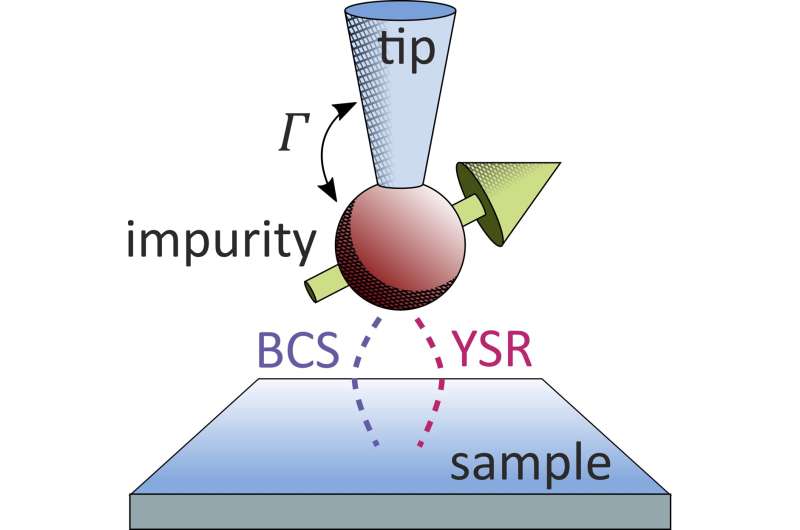August 2, 2022 feature
Researchers measure a signature of superconducting interference at the atomic scale

Superconductors, materials that can conduct electricity with no resistance at low temperatures, have many interesting and advantageous properties. In recent years, physicists and computer scientists have been investigating their potential for different applications, including quantum computing technology.
Magnetic impurities coupled to a superconductor can produce so-called Yu-Shiba-Rusinov (YSR) states inside the superconducting gap. When the coupling of these impurities to the superconductors increases, the YSR state undergoes a quantum phase transition, causing the material's ground state to change. While many physicists have investigated YSR states and their quantum phase transition over the past few years, their effect on the ground state of superconductors is still poorly understood.
Researchers at the Max Planck Institute for Solid State Research, Ulm University, the German Aerospace Center (DLR), Uppsala University and the Autonomous University of Madrid have recently carried out a study aimed at gathering new insight about ground state changes associated with YSR states. Their study, featured in Nature Physics, led to the detailed observation of a change in the so-called Josephson current as a signature of the YSR state's phase transition.
"While YSR states have been extensively studied over the past years and there are indirect indications that the YSR state undergoes a quantum phase transition, a direct indication of how the ground state changes has been missing," Christian Ast, one of the researchers who carried out the study, told Phys.org. "Basically, the quantum phase transition could be observed, but it was never quite clear on which side of the quantum phase transition one was. If the exchange coupling is weak, the impurity spin is free (the YSR state is empty in the ground state) and if the exchange coupling is strong, the impurity spin is screened by occupying the YSR state in the ground state."
When coupled to superconductors, spins in quantum dots create what is known as a p-Josephson junction, a reversal in the material's supercurrent that can be observed by measuring the Josephson current, also known as supercurrent or Cooper pair current. Ast and his colleagues thus set out to measure the Josephson current through a YSR state and across this state's quantum phase transition.
"The Josephson current can tell us on which side of the quantum phase transition the YSR state is," Ast explained.
Firstly, the researchers used a mK-STM, a scanning tunneling microscope that operates at a base temperature of 10mK, to locally measure a single impurity with a YSR state in their sample. Their experiments were carried out at the Max Planck Institute for Solid State Research's Precision Lab, which hosts the mK-STM.
"To observe the supercurrent reversal, we had to employ a very tricky detail," Ast said. "The supercurrent reversal is due to a phase shift across the tunnel junction. To be precise, the phase shifts by p, i.e., 180 degrees, which is equivalent to a sign change, which is why these junctions are referred to as p-junctions and I guess, this sign change coined the term 'supercurrent reversal.'"
Phase changes such as those probed by Ast and his colleagues are very difficult to detect experimentally. Typically, detecting these changes requires a second tunnel junction that can be used as a reference junction. So far, most researchers have detected phase changes using what is known as a superconducting quantum interference device (SQUID).
SQUIDs are very sensitive devices that can detect and measure subtle magnetic fields, currents, voltages or displacements. These devices are based on the Josephson effect and they measure changes in Josephson currents.
"We have mimicked such a device by exploiting a second transport channel in our tunnel junction, which serves as a reference junction," Ast said. "As a result, we see constructive interference on one side of the quantum phase transition and destructive interference between the two channels on the other side, which manifests itself in a change in the magnitude of the Josephson current."
During their study, Ast and his colleagues introduced what could be described as the smallest SQUID device developed so far. Using this device, they detected the 0-p transition in the YSR state produced by a magnetic impurity inside a semiconductor.
"The main difference between a conventional SQUID and our device is that we do not have a superconducting loop through which we can pass a magnetic field to tune the phase," Ast explained. Therefore, we can only detect a sign change, which is quite enough for our purpose. With our device, we successfully detected the phase change in the 0-p transition of the YSR state across the quantum phase transition."
This change in the Josephson current measured by this team of researchers is a clear signature of a change in the ground state produced by the YSR state during its quantum phase transition. Ast and his colleagues were able to detect this change by exploiting the interference between two tunneling channels in the Josephson effect for the very first time, thus using their "miniature" SQUID as a sensor.
In their next studies, the researchers hope to gather new insight about phase changes in superconductors using the sensor introduced in their paper and other new devices. Ultimately, their mission is to unveil new quantum limits by reducing systems to their bare minimum, suppressing their interactions and shrinking them to the atomic level.
"The physics of these systems can be modeled by comparatively simple theories, which makes the result beautiful," Ast added. "This work is one milestone in this quest for new quantum limits. Aside from this general goal, we are looking to exploit this newly discovered phase sensitivity in the functionalized YSR tips to detect other exotic phenomena."
More information: Sujoy Karan et al, Superconducting quantum interference at the atomic scale, Nature Physics (2022). DOI: 10.1038/s41567-022-01644-6
Journal information: Nature Physics
© 2022 Science X Network




















